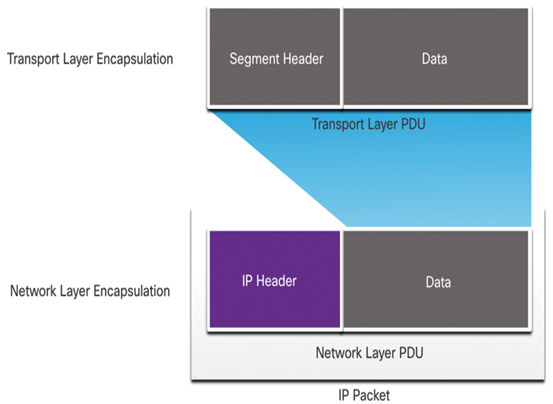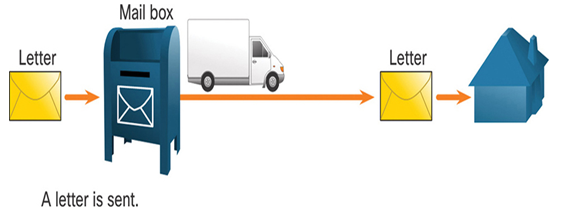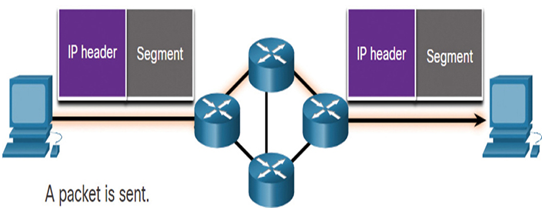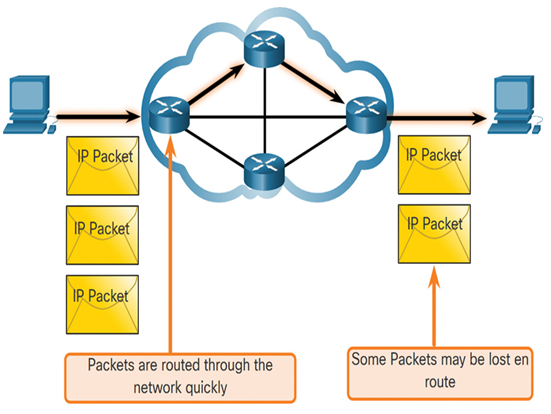IP encapsulates the transport layer (the layer just above the network layer) segment or other data by adding an IP header. The IP header is used to deliver the packet to the destination host.
Figure 22-2 illustrates how the transport layer PDU is encapsulated by the network layer PDU to create an IP packet.

Figure 22-2 Transport Layer Encapsulated in the Network Layer
The process of encapsulating data layer by layer enables the services at the different layers to develop and scale without affecting the other layers. This means the transport layer segments can be readily packaged by IPv4 or IPv6 or by any new protocol that might be developed in the future.
The IP header is examined by Layer 3 devices (i.e., routers and Layer 3 switches) as it travels across a network to its destination. It is important to note, that the IP addressing information remains the same from the time the packet leaves the source host until it arrives at the destination host, except when translated by the device performing Network Address Translation (NAT) for IPv4.
Note:
NAT is discussed in later modules.
Routers implement routing protocols to route packets between networks. The routing performed by these intermediary devices examines the network layer addressing in the packet header. In all cases, the data portion of the packet, that is, the encapsulated transport layer PDU or other data, remains unchanged during the network layer processes.
Characteristics of IP (22.1.4)
IP was designed as a protocol with low overhead. It provides only the functions that are necessary to deliver a packet from a source to a destination over an interconnected system of networks. The protocol was not designed to track and manage the flow of packets. These functions, if required, are performed by other protocols at other layers, primarily TCP at Layer 4.
These are the basic characteristics of IP:
• Connectionless — There is no connection with the destination established before sending data packets.
• Best Effort — IP is inherently unreliable because packet delivery is not guaranteed.
• Media Independent — Operation is independent of the medium (i.e., copper, fiber-optic, or wireless) carrying the data.
IP is connectionless, meaning that no dedicated end-to-end connection is created by IP before data is sent. Connectionless communication is conceptually similar to sending a letter to someone without notifying the recipient in advance. Figure 22-3 summarizes this key point.

Figure 22-3 Letter Analogy of Connectionless Communication
Connectionless data communications work on the same principle. As shown in Figure 22-4, IP requires no initial exchange of control information to establish an end-to-end connection before packets are forwarded.

Figure 22-4 IP is Connectionless
IP also does not require additional fields in the header to maintain an established connection. This process greatly reduces the overhead of IP. However, with no pre-established end-to-end connection, senders are unaware whether destination devices are present and functional when sending packets, nor are they aware if the destination receives the packet, or if the destination device is able to access and read the packet.
The IP protocol does not guarantee that all packets that are delivered are, in fact, received. Figure 22-5 illustrates the unreliable or best-effort delivery characteristic of the IP protocol. As an unreliable network layer protocol, IP does not guarantee that all sent packets will be received. Other protocols manage the process of tracking packets and ensuring their delivery.

Figure 22-5 Best Effort Delivery
